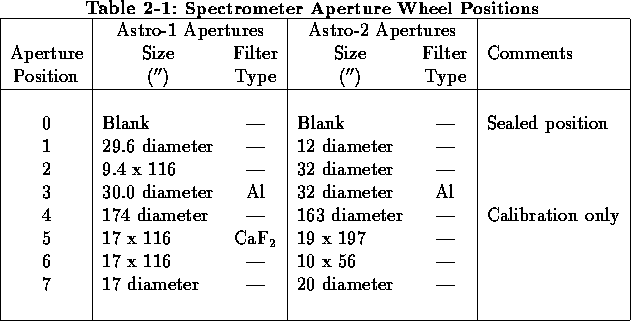
The aperture wheel assembly consists of a housing, a drive motor with reduction gearing, a mechanical geneva mechanism for indexing the wheel, and an aperture wheel. Only the wheel is shown in cross section in Figure 2-4. The aperture wheel is made of titanium and has a thin disk of nickel-plated copper mounted to its upper surface. There are eight positions, seven of which contain accurately etched holes to admit light into the spectrometer and one of which has no hole to provide a vacuum seal. The aperture positions and sizes for the Astro-2 configuration of HUT are given in Table 2-1.
The axis of the wheel is tilted 22.5![]() to the optical axis of the
telescope. The nickel surface of the disk is optically smooth so that
the image of the field surrounding the source is reflected into the TV
camera, which is mounted on one of the spider arms at 45
to the optical axis of the
telescope. The nickel surface of the disk is optically smooth so that
the image of the field surrounding the source is reflected into the TV
camera, which is mounted on one of the spider arms at 45![]() to the
optical axis of the telescope. The geneva mechanism uses approximately
one half of a drive wheel cycle to rotate the wheel 45
to the
optical axis of the telescope. The geneva mechanism uses approximately
one half of a drive wheel cycle to rotate the wheel 45![]() and the
remaining drive wheel cycle to unclamp and reclamp the aperture wheel
to provide a vacuum seal for the spectrometer. The nominal time to
move one aperture position is 25.6 sec. The final position of the
wheel is dependent solely on mechanical tolerances of the geneva
mechanism. The accuracy of placement is
and the
remaining drive wheel cycle to unclamp and reclamp the aperture wheel
to provide a vacuum seal for the spectrometer. The nominal time to
move one aperture position is 25.6 sec. The final position of the
wheel is dependent solely on mechanical tolerances of the geneva
mechanism. The accuracy of placement is ![]() 0.6
0.6![]() projected onto the sky or
projected onto the sky or ![]() 5
5 ![]() m in the focus direction. The
position of the center of each aperture, in TV camera coordinates, is
maintained in the DEP memory. For the purpose of target
acquisition, a fiducial mark representing the aperture to be used
during an observation is generated by the DEP and placed in the video
image. There is a small amount of backlash in the drive motor gearing
which must be accounted for by the DEP when generating the location of
the aperture.
m in the focus direction. The
position of the center of each aperture, in TV camera coordinates, is
maintained in the DEP memory. For the purpose of target
acquisition, a fiducial mark representing the aperture to be used
during an observation is generated by the DEP and placed in the video
image. There is a small amount of backlash in the drive motor gearing
which must be accounted for by the DEP when generating the location of
the aperture.